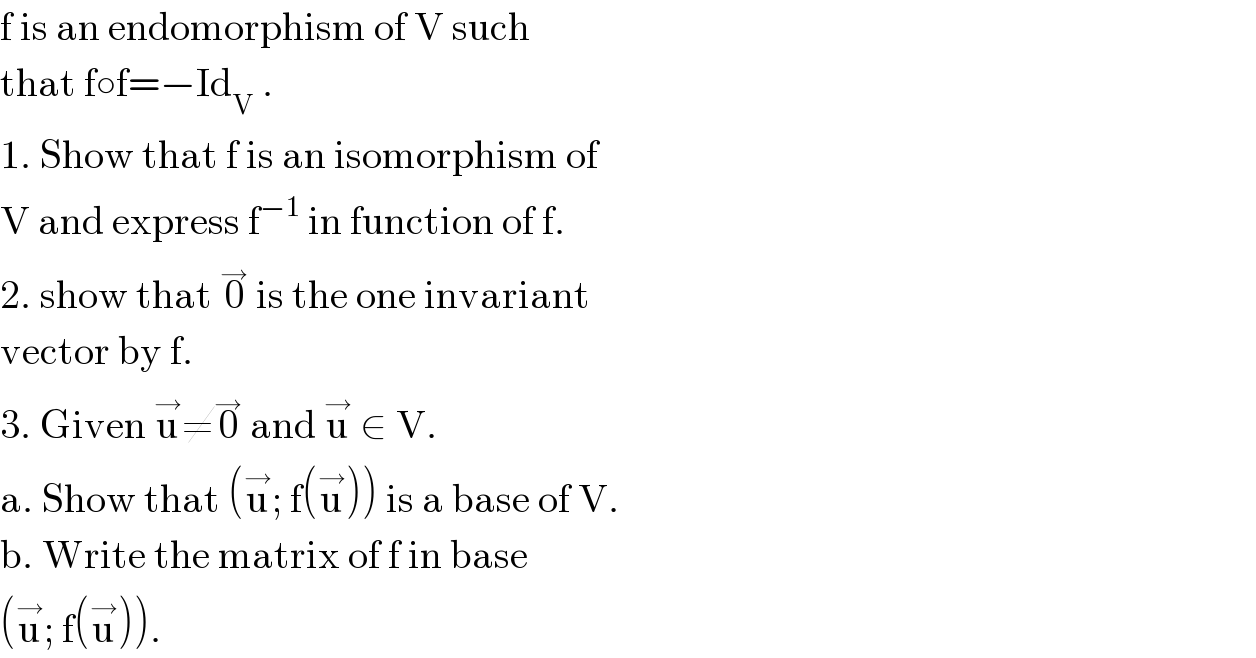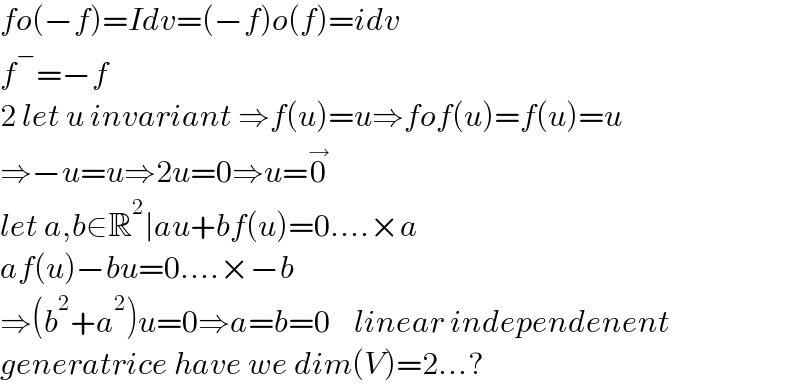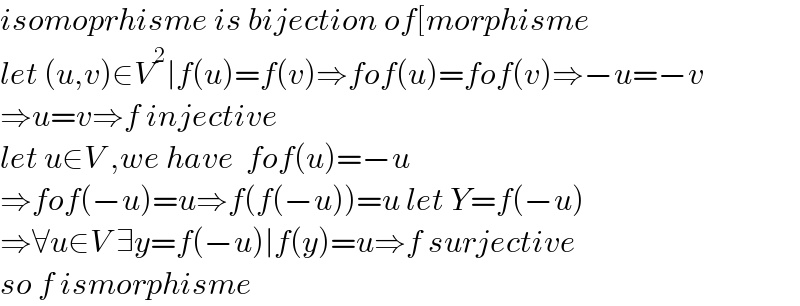
Question Number 142236 by mathocean1 last updated on 28/May/21

$$\mathrm{f}\:\mathrm{is}\:\mathrm{an}\:\mathrm{endomorphism}\:\mathrm{of}\:\mathrm{V}\:\mathrm{such} \\ $$$$\mathrm{that}\:\mathrm{f}\circ\mathrm{f}=−\mathrm{Id}_{\mathrm{V}} \:. \\ $$$$\mathrm{1}.\:\mathrm{Show}\:\mathrm{that}\:\mathrm{f}\:\mathrm{is}\:\mathrm{an}\:\mathrm{isomorphism}\:\mathrm{of} \\ $$$$\mathrm{V}\:\mathrm{and}\:\mathrm{express}\:\mathrm{f}^{−\mathrm{1}} \:\mathrm{in}\:\mathrm{function}\:\mathrm{of}\:\mathrm{f}. \\ $$$$\mathrm{2}.\:\mathrm{show}\:\mathrm{that}\:\overset{\rightarrow} {\mathrm{0}}\:\mathrm{is}\:\mathrm{the}\:\mathrm{one}\:\mathrm{invariant} \\ $$$$\mathrm{vector}\:\mathrm{by}\:\mathrm{f}. \\ $$$$\mathrm{3}.\:\mathrm{Given}\:\overset{\rightarrow} {\mathrm{u}}\neq\overset{\rightarrow} {\mathrm{0}}\:\mathrm{and}\:\overset{\rightarrow} {\mathrm{u}}\:\in\:\mathrm{V}. \\ $$$$\mathrm{a}.\:\mathrm{Show}\:\mathrm{that}\:\left(\overset{\rightarrow} {\mathrm{u}};\:\mathrm{f}\left(\overset{\rightarrow} {\mathrm{u}}\right)\right)\:\mathrm{is}\:\mathrm{a}\:\mathrm{base}\:\mathrm{of}\:\mathrm{V}. \\ $$$$\mathrm{b}.\:\mathrm{Write}\:\mathrm{the}\:\mathrm{matrix}\:\mathrm{of}\:\mathrm{f}\:\mathrm{in}\:\mathrm{base} \\ $$$$\left(\overset{\rightarrow} {\mathrm{u}};\:\mathrm{f}\left(\overset{\rightarrow} {\mathrm{u}}\right)\right). \\ $$
Answered by mindispower last updated on 28/May/21

$${fo}\left(−{f}\right)={Idv}=\left(−{f}\right){o}\left({f}\right)={idv} \\ $$$${f}^{−} =−{f} \\ $$$$\mathrm{2}\:{let}\:{u}\:{invariant}\:\Rightarrow{f}\left({u}\right)={u}\Rightarrow{fof}\left({u}\right)={f}\left({u}\right)={u} \\ $$$$\Rightarrow−{u}={u}\Rightarrow\mathrm{2}{u}=\mathrm{0}\Rightarrow{u}=\overset{\rightarrow} {\mathrm{0}} \\ $$$${let}\:{a},{b}\in\mathbb{R}^{\mathrm{2}} \mid{au}+{bf}\left({u}\right)=\mathrm{0}....×{a} \\ $$$${af}\left({u}\right)−{bu}=\mathrm{0}....×−{b} \\ $$$$\Rightarrow\left({b}^{\mathrm{2}} +{a}^{\mathrm{2}} \right){u}=\mathrm{0}\Rightarrow{a}={b}=\mathrm{0}\:\:\:\:{linear}\:{independenent} \\ $$$${generatrice}\:{have}\:{we}\:{dim}\left({V}\right)=\mathrm{2}...? \\ $$
Commented by mathocean1 last updated on 28/May/21

$${thank}\:{you}\:{sir}. \\ $$$${yes}\:{dim}\left({V}\right)=\mathrm{2}. \\ $$$${what}\:{could}\:{be}\:{the}\:{matrix}.. \\ $$
Commented by mindispower last updated on 28/May/21

$$\begin{pmatrix}{\mathrm{0}\:−\mathrm{1}}\\{\mathrm{1}\:\:\:\:\:\mathrm{0}}\end{pmatrix}\:\:\: \\ $$
Commented by mathocean1 last updated on 29/May/21

$${Thanks} \\ $$
Commented by mindispower last updated on 29/May/21

$${pleasur} \\ $$
Answered by mindispower last updated on 28/May/21

$${isomoprhisme}\:{is}\:{bijection}\:{of}\left[{morphisme}\right. \\ $$$${let}\:\left({u},{v}\right)\in{V}^{\mathrm{2}} \mid{f}\left({u}\right)={f}\left({v}\right)\Rightarrow{fof}\left({u}\right)={fof}\left({v}\right)\Rightarrow−{u}=−{v} \\ $$$$\Rightarrow{u}={v}\Rightarrow{f}\:{injective} \\ $$$${let}\:{u}\in{V}\:,{we}\:{have}\:\:{fof}\left({u}\right)=−{u} \\ $$$$\Rightarrow{fof}\left(−{u}\right)={u}\Rightarrow{f}\left({f}\left(−{u}\right)\right)={u}\:{let}\:{Y}={f}\left(−{u}\right) \\ $$$$\Rightarrow\forall{u}\in{V}\:\exists{y}={f}\left(−{u}\right)\mid{f}\left({y}\right)={u}\Rightarrow{f}\:{surjective} \\ $$$${so}\:{f}\:{ismorphisme} \\ $$
